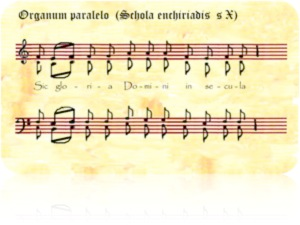Lesson 4: Medieval Music
Lesson 4: Medieval Music

Lesson 4: Medieval Music
Medieval Music
As time passed and the ancient empires and civilizations collapsed or were conquered by others, the music moved closer to what we are familiar with today. After the fall of the Roman Empire, Europe moved toward what we now refer to as the Middle Ages or medieval times. Medieval music is the music that was produced in medieval Europe. Typically, this period of time is thought to begin with the fall of the Roman Empire and ended with the rise of the Renaissance period in Europe. Thus, medieval music occurred from about 500 CE through the early 1400s.
Early medieval music was often connected with spiritual and religious activities and beliefs. The Catholic Church grew in power during this period, filling a leadership role that weaker governments had trouble doing. One of the effects of this was that the Church had a great deal of influence and control over the arts, including music. As religious leaders wanted to distance religion from the paganism that was associated with ancient Greek and Roman cultures, the music of the Middle Ages was often very different from that of the Greek and Roman empires. In addition, musicians were often employed by the Church or other religious institution, and a great deal of medieval music was actually produced within monasteries.
One of the early types of medieval music was the chant. Chants (also known as plainsong) are a type of monophonic sacred music. Medieval chants had a strong influence in the chants or singing of songs in both the Jewish and early Christian traditions. Chants were commonly sung by monks during religious services, and the melodies that the chants were recited to were often simple ones. Since various societies within Europe were still relatively isolated, even while connected to the Catholic Church as a whole, the chants developed their own styles in different places. For example, the chants that developed in Spain showed the influence of North African music.
Chant Example
In 600 CE, Pope Gregory I wanted to standardize the chants that were used during Mass, which led to Gregorian chant. Gregorian chants were often sung by male choirs and the music is still used for worship today. Like the music in previous time periods, medieval music was often based on modes. Modes were used before the modern day scales that we are more familiar with. They were 'a series of pitches in predefined order, with specific intervals between each pitch.' Seven different modes were used to compose and play music: Ionian, Dorian, Phrygian, Lydian, Mixolydian, Aeolian, and Locrian. Each of these modes starts on a different note and continues on the major scale. For example, the Dorian mode begins on D and moves upward from there (so the mode would be D, E, F, G, A, B, C, D). Likewise, the Phrygian mode begins on E and moves up the major scale to also end in E. Gregorian chants used these simple modes.
Monophonic music dominated the early Middle Ages, but polyphonic music gradually grew in popularity and use, particularly after about 900 CE. Polyphonic music uses two or more independent melodies. Gradually, musicians and singers began to add harmonies to the chants. Early examples were fairly simple, with a second voice singing a fourth or fifth interval above the melody. Over time, this became more complex, with the addition of more voices and counter melodies.
Organum
One of the first polyphonic forms of music to develop was organum. Organum was the addition of a second voice, sung in tandem, to Gregorian chants. Generally, the second voice harmonized with the melody at an interval below the main melody. In other words, when the main melody went up or down, the second voice did as well. One of the most famous organum composers during this period was Hildegard von Bingen, who lived in the twelfth century. She wrote loose poetic verses accompanied by melodies.
Another musical form that developed was the conductus. Also polyphonic, conductus was similar to an organum, but the speed of the song was quicker. Scholars believe that this form of music began in France about 1150 CE. The topics of the songs were often sacred, although they were not typically part of the liturgy of the mass. The songs were often about saints, feasts, and even criticisms about the clergy.
Not all of the music of the medieval period was as simple as the chant. Ars Nova, a musical form that became popular in the late medieval period, featured multiple voices with a complex rhythm. The music layered multiple voices over each other in complex ways. It is generally associated with the fourteenth century music. The music was controversial at the time because some composers mixed sacred music (chants and other texts) with secular music (about love or other topics). Because of this, Pope John XXII rejected the music (although later popes accepted it).
While religious music was important during the medieval time period, secular music was played. As time passed, more secular music began to enter the Middle Ages and its culture. One form of secular music was the music of the troubadours. Troubadours were traveling poet-musicians who traveled from place to place, singing and performing for the nobility. The songs that they sang were generally monophonic and the troubadour often accompanied himself with an instrument such as a lyre or even drums. The melodies were sometimes based on those produced for religious purposes, although they were often simpler and had a faster tempo. The topics of the songs were varied, but courtly love was a popular one.